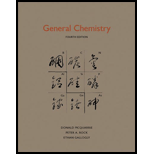
Concept explainers
(a)
Interpretation:
SI unit conversion has to be performed for
Concept Introduction:
Conversion of one unit into another unit is done by the use of unit conversion factor. This involves multiplying or dividing by the power of 10. For example, if centimeter has to be converted into meter, then the given value in centimeter has to be multiplied by the conversion factor as shown below.
(a)
Explanation of Solution
Given value is
As the given value is in joules, the first conversion factor is considered. The SI unit conversion is performed as shown below.
Therefore, the SI unit converted value of
(b)
Interpretation:
SI unit conversion has to be performed for
Concept Introduction:
Refer part (a).
(b)
Explanation of Solution
Given value is
As the given value is in joules, the first conversion factor is considered. The SI unit conversion is performed as shown below.
Therefore, the SI unit converted value of
(c)
Interpretation:
SI unit conversion has to be performed for
Concept Introduction:
Refer part (a).
(c)
Explanation of Solution
Given value is
As the given value is in megajoules, the conversion is done using the conversion factors as shown below.
Therefore, the SI unit converted value of
(d)
Interpretation:
SI unit conversion has to be performed for
Concept Introduction:
Refer part (a).
(d)
Explanation of Solution
Given value is
As the given value is in nanoseconds, the conversion to femtosecond can be done as shown below using conversion factors.
Therefore, the SI unit converted value of
(e)
Interpretation:
SI unit conversion has to be performed for
Concept Introduction:
Refer part (a).
(e)
Explanation of Solution
Given value is
As the given value is in cubicmeter, the second conversion factor is used. This is performed as shown below.
Therefore, the SI unit converted value of
Want to see more full solutions like this?
Chapter 1 Solutions
General Chemistry
 ChemistryChemistryISBN:9781305957404Author:Steven S. Zumdahl, Susan A. Zumdahl, Donald J. DeCostePublisher:Cengage Learning
ChemistryChemistryISBN:9781305957404Author:Steven S. Zumdahl, Susan A. Zumdahl, Donald J. DeCostePublisher:Cengage Learning ChemistryChemistryISBN:9781259911156Author:Raymond Chang Dr., Jason Overby ProfessorPublisher:McGraw-Hill Education
ChemistryChemistryISBN:9781259911156Author:Raymond Chang Dr., Jason Overby ProfessorPublisher:McGraw-Hill Education Principles of Instrumental AnalysisChemistryISBN:9781305577213Author:Douglas A. Skoog, F. James Holler, Stanley R. CrouchPublisher:Cengage Learning
Principles of Instrumental AnalysisChemistryISBN:9781305577213Author:Douglas A. Skoog, F. James Holler, Stanley R. CrouchPublisher:Cengage Learning Organic ChemistryChemistryISBN:9780078021558Author:Janice Gorzynski Smith Dr.Publisher:McGraw-Hill Education
Organic ChemistryChemistryISBN:9780078021558Author:Janice Gorzynski Smith Dr.Publisher:McGraw-Hill Education Chemistry: Principles and ReactionsChemistryISBN:9781305079373Author:William L. Masterton, Cecile N. HurleyPublisher:Cengage Learning
Chemistry: Principles and ReactionsChemistryISBN:9781305079373Author:William L. Masterton, Cecile N. HurleyPublisher:Cengage Learning Elementary Principles of Chemical Processes, Bind...ChemistryISBN:9781118431221Author:Richard M. Felder, Ronald W. Rousseau, Lisa G. BullardPublisher:WILEY
Elementary Principles of Chemical Processes, Bind...ChemistryISBN:9781118431221Author:Richard M. Felder, Ronald W. Rousseau, Lisa G. BullardPublisher:WILEY





